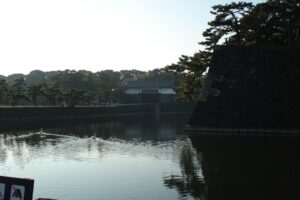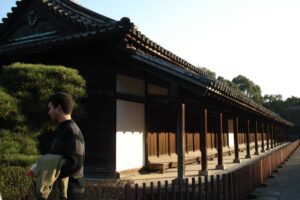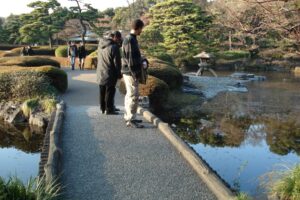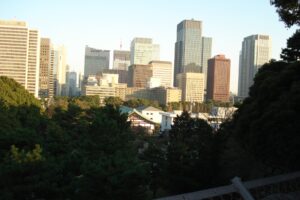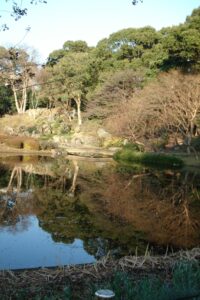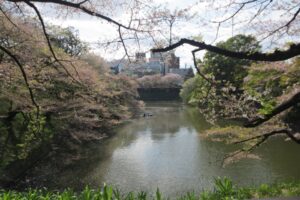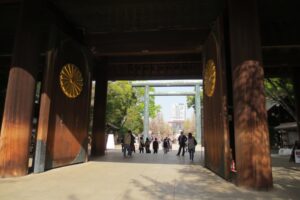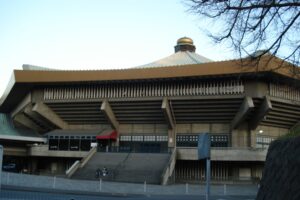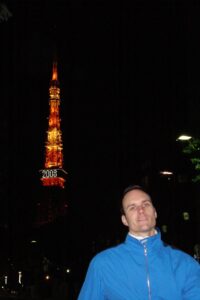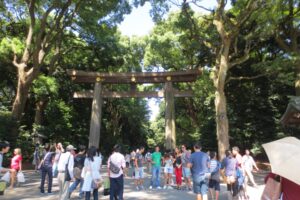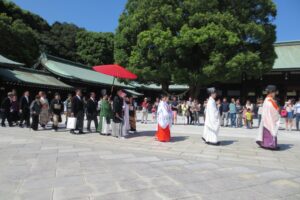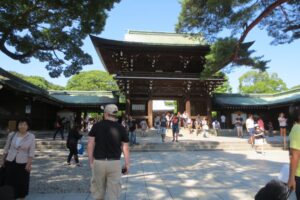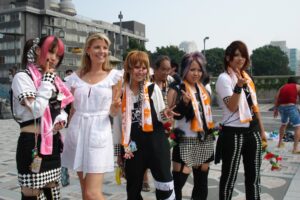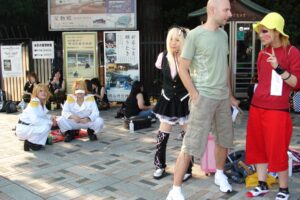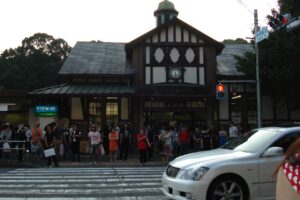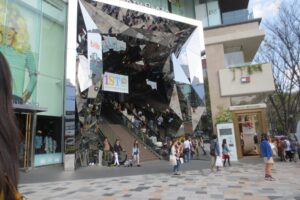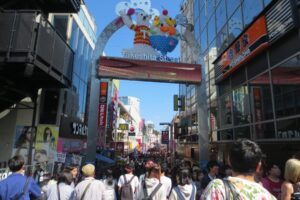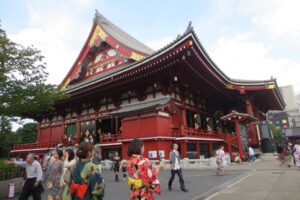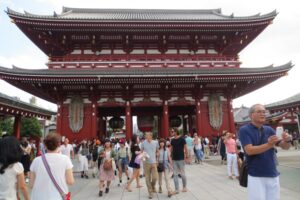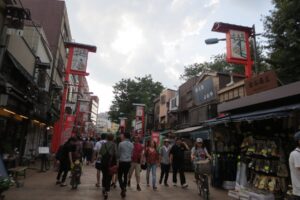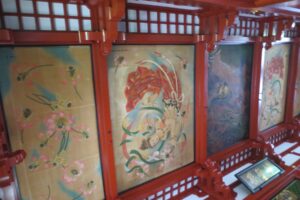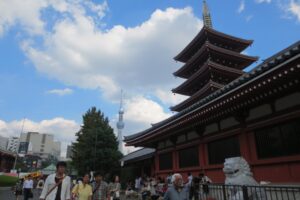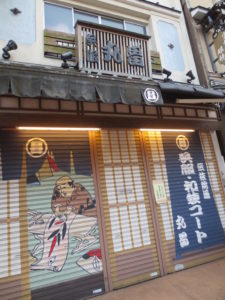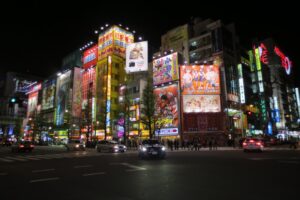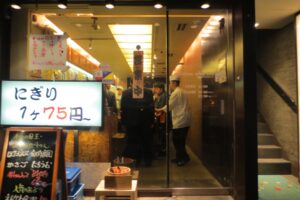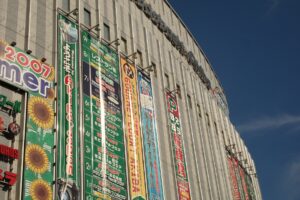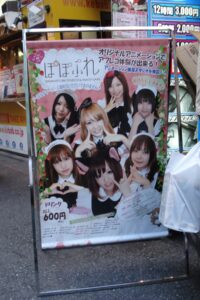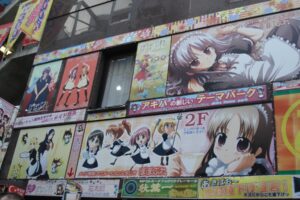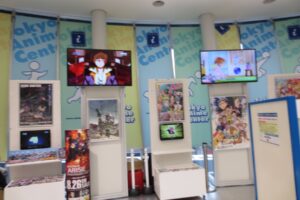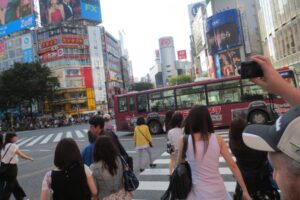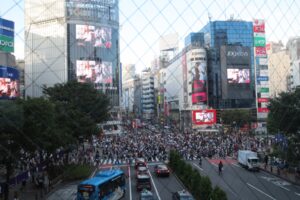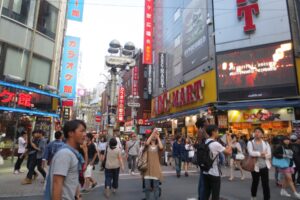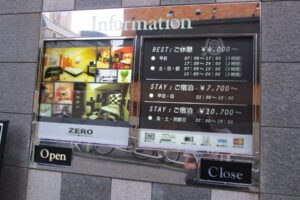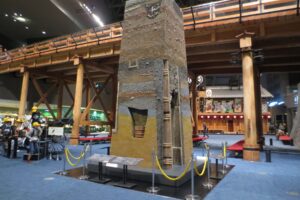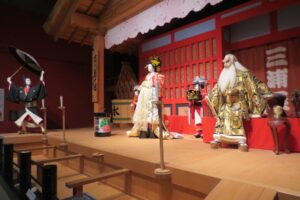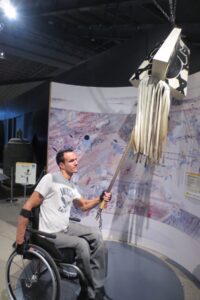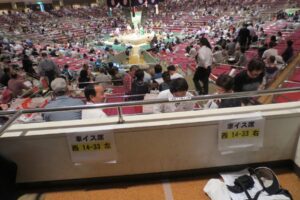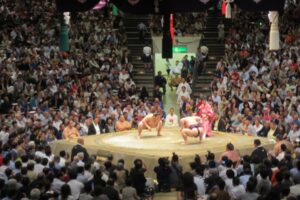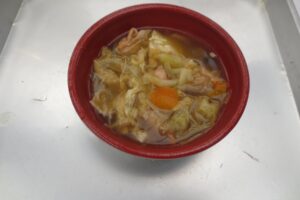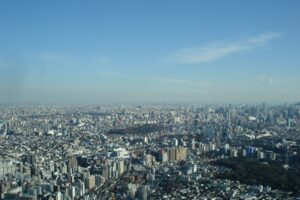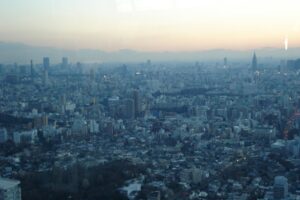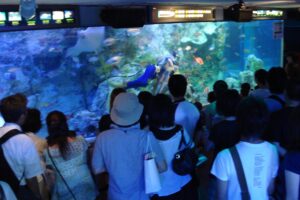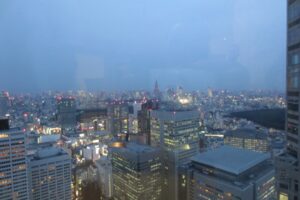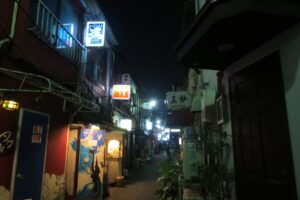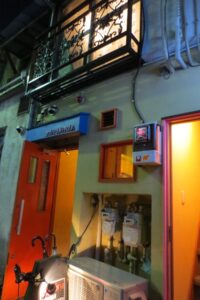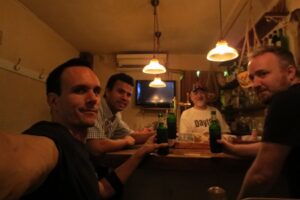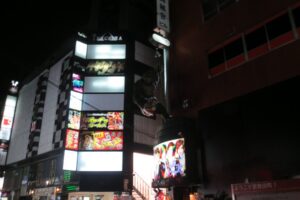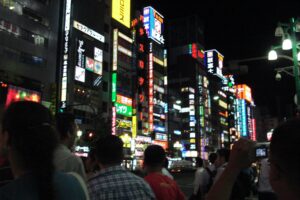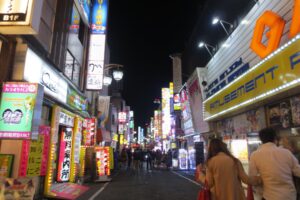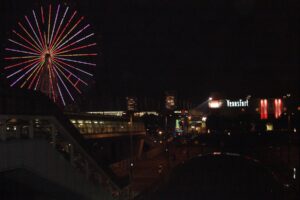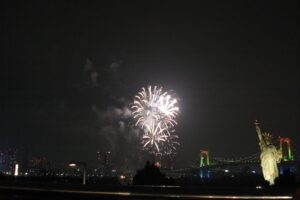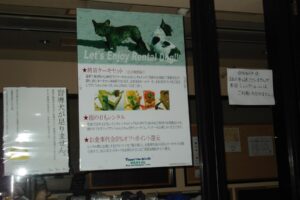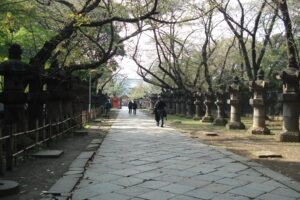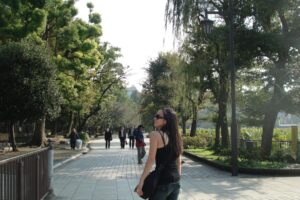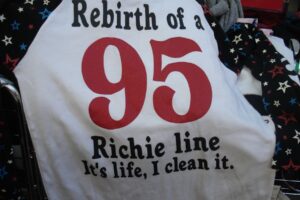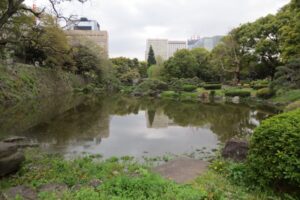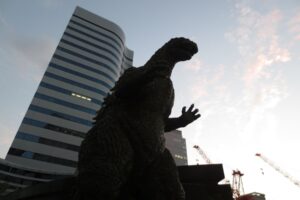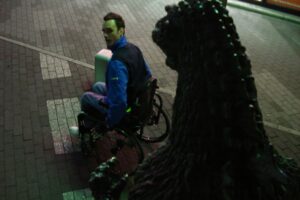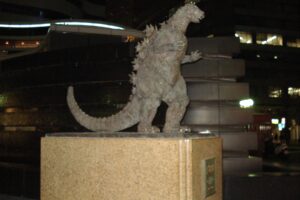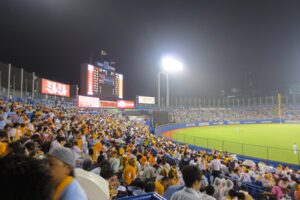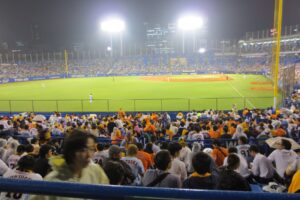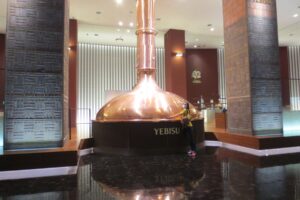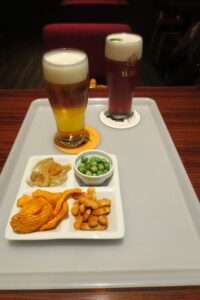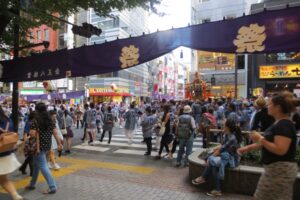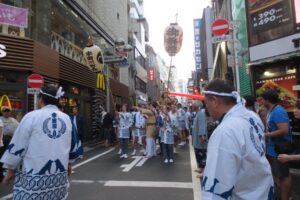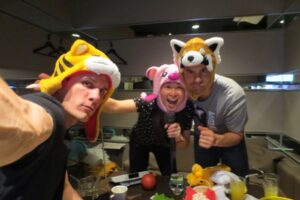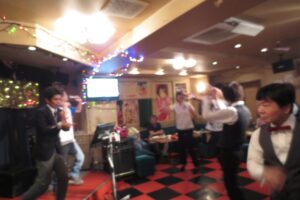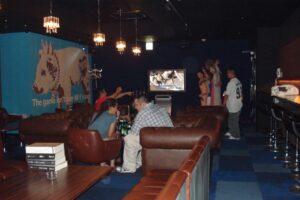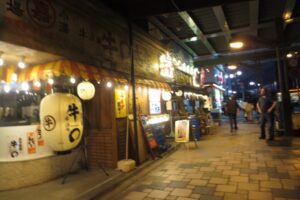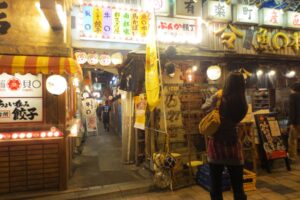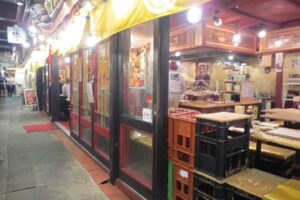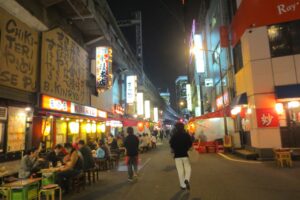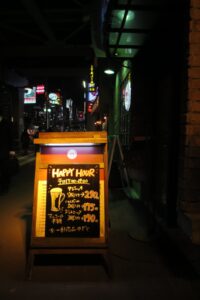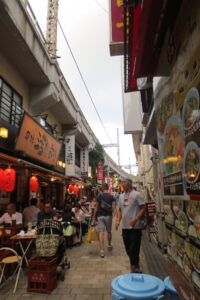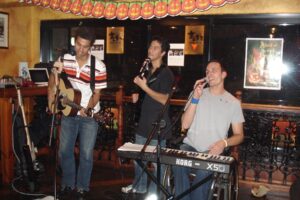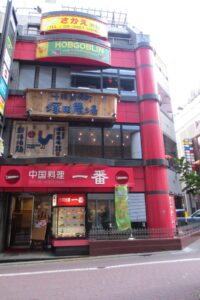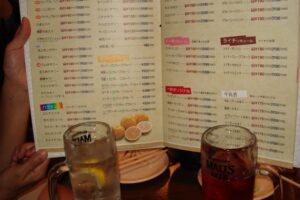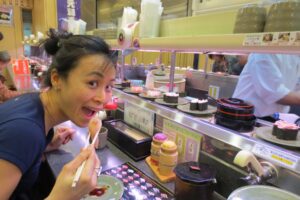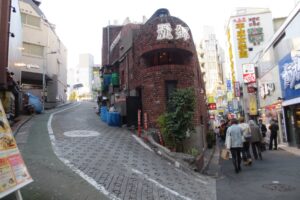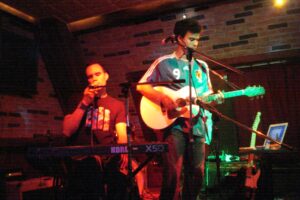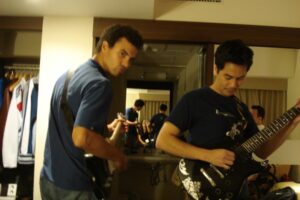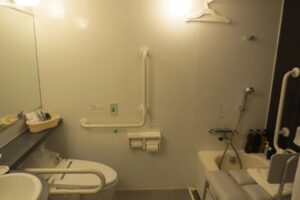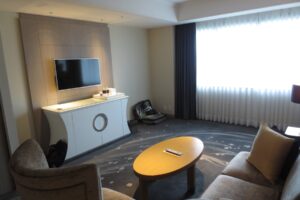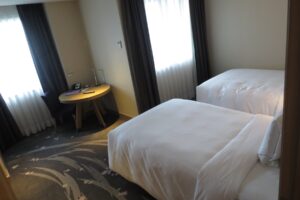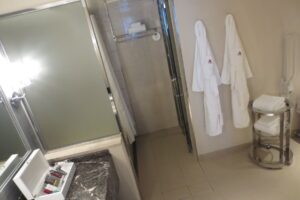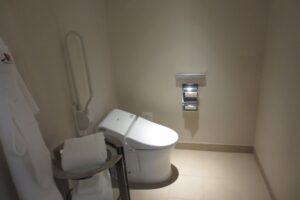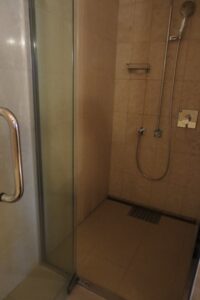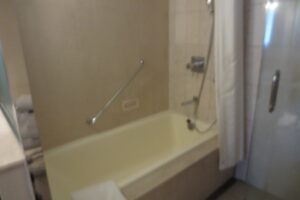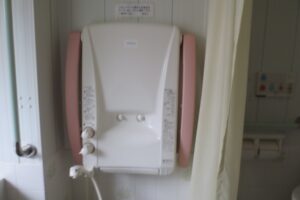The capital and Japan’s largest city. There’s no shortage of things to do or see in this bustling metropolis! While most cities have a main downtown or entertainment district, Tokyo has several – the majority of which are located along the JR Yamanote line (i.e. the train line that loops around central Tokyo). There are several other JR and metro/subway lines that link up and bisect the Yamanote, so no matter where you’re staying in the city, it won’t take you long to reach your destination!
Suggested duration of stay: Regardless of how long you visit, there’s always going to be more things to see. If you’re pressed for time or an itinerary fiend, you might be able to get a feel for the city in 5 days, but I would normally suggest 1 week.
Getting around:
Trains, trains, and more trains! You will never find another city or country that has this many train lines & routes! It’s truly unbelievable how efficiently everything runs and depending on which airport you fly into, there are express trains, local trains, and trains with several adjectives, like the ‘special rapid service’ that are ready to take you to your destination. The Narita Express is a comfortable, high-speed train that takes roughly an hour to go from Narita airport (NRT) to Tokyo Station and beyond. But depending on your budget and where you’re staying, you might be better off taking a Special Rapid train into the city. It’s about half the price and only takes an extra 10 mins to get to Nippori station, on the aforementioned JR Yamanote line. Just make sure to buy a Suica card, when you first arrive, and load it up with some cash (at least 2000 yen to start). It works on the JR train lines, Tokyo Metro (subway lines), and even on some vending machines too! It’s fast, convenient, and saves you from purchasing tickets, every time you head out.
Haneda Airport (HND) is closer to central Tokyo, so the express trains only take ~30 mins to reach Shinagawa station – which is not only on the Yamanote Line, but also acts as hub to the majority of the city’s train lines and shinkansen (bullet trains) too.
Once you’re in the city, you have numerous JR (Japan Rail) train lines and subways that you can access. Just be aware that many of the trains are not flush/level with the platform! If you have trouble negotiating a 3-4″ (7-10 cm) height differential, you should let the attendants know, when you arrive at the station. They will assist you with a ramp to get you on the train and will call ahead to your destination, to ensure that an attendant with a ramp is ready to help you off (I’m able to do a wheelie and use the handle on the inside of the doors to pull myself in). Also, don’t be afraid to buzz or ask for help, if you don’t see an elevator at a particular station. In some cases, the staff will be able to lock off part of an escalator (i.e. 3 steps), to create a flat platform for a wheelchair! I’ve also been carried up the stairs by several attendants, when I arrived at a station that didn’t have a lift or lockable escalator. So, basically, it never hurts to ask and in the worst case, the next station is likely 5 minutes down the road.
Visually impaired visitors will also be happy to know that Japan is a pioneer, when it comes to tactile paving. Most city streets and all of the train platforms are equipped with raised, striped or dotted tiles, to warn of grade changes and hazardous drop-offs (i.e. traffic intersections or platform edges).
What I saw:
Imperial Palace – Home to the Emperor and his family, since 1888 (the opening date of the original palace, which burnt down in World War 2), the palace is a short walk from iconic Tokyo Station. There are a few things to see here, but if you’re in a chair, you’ll find getting around the entire grounds challenging, as there’s a steep hill to negotiate (in one section, near the end). You can also venture north of the palace to see the Nippon Budokan (the famous music and martial arts venue), the Science and National Art Museums, Kitanomaru Park (great spot for cherry blossom viewing), and the Yasukuni Shrine (dedicated to Japan’s fallen soldiers).
- The moat around the Imperial Palace
- Imperial Palace barracks
- Emperor’s residence – behind the trees – with the city as its backdrop
- Palace gardens & pond
- Cherry blossoms at Kitanomaru
- Gate doors at Yasukuni Shrine
- The Budokan
Tokyo Tower – Fairly self-explanatory, though they did recently build the (taller) Tokyo Skytree. This 333 meter tower opened in 1958 and still serves as a broadcast antenna. It also plays an important part in Japan’s annual “Red and White Song Battle“, every New Year’s Eve, where the men and women of Japan’s music industry seek bragging rights in a battle of the sexes. The winning team is revealed, when the tower is illuminated in the victor’s colours – white for the men or red for the women. Speaking of which, towers – especially at night – are very popular date spots. Just sayin’…
Meiji Shrine – Dedicated to Emperor Meiji, this is one of Tokyo’s largest shrines and its wooded surroundings connect to Yoyogi Park – creating a huge green space in one of Tokyo’s densest urban areas. The gravel path leading to the shrine is rather lengthy and may pose problems for mobility devices (especially in spots where the gravel is deep), so you may want to have somebody with you, just in case. There’s also a paved service road that goes around the outside of the grounds. I’ve utilized that to get back to the main entrance vs. back-tracking and going for round 2 on the gravel path. 😉
- Meiji Shrine Torii
- Wedding procession at the Meiji Shrine
Harajuku – A major fashion district for Japanese youth, it has two distinct shopping streets: Takeshita Street (always packed and the name alone brings joy to sophomoric English speakers 😉 & Cat Street – plus the main avenue ‘Omotesando’, which has many big name stores. This area was also the home to the once proud “Harajuku Girls”, who would dress up in outrageously-unique outfits on Sundays and hang out on the Jingu Bashi bridge (which is beside the Meiji Shrine’s main torii/gate), but this practice seems to have died out recently. Some say the fad ran its course and that they’ve moved elsewhere in the city – in fashions that blend in a little better with the mainstream – but I’ve also heard rumour that Madonna’s depiction of them in one of her tours is to blame…discuss amongst yourselves!
- J posing with some Harajuku Girls
- Harajuku girls on the bridge (Jingu Bashi) beside the Meiji Shrine entrance
- Harajuku Station (JR)
- Retail shops on Omotesando
- Takeshita Street
- Cat Street – heading towards Shibuya
Asakusa – Located in Tokyo’s north end and home to it’s oldest Buddhist temple Sensoji, this area is a throwback to the Edo Period and features a shopping street with traditional, local snacks and souvenirs. Sensoji has a small elevator for mobility-impaired visitors, to allow them access to the main hall.
- Sensoji (the elevator’s behind the girl in the red kimono)
- Sensoji Main gate
- Asakusa vendors – near the temple
- Ceiling artwork inside Sensoji main hall
- Pagoda with Tokyo Skytree in the distance
- Classic artwork from the Edo Period on Asakusa store fronts
Akihabara – The ‘electronic city’, but also home to maid cafés, cosplay, and the animé museum (which wasn’t really a museum, per se, as it’s surprisingly small and there was no admission). You can grab cheap electronics, small electrical components (for that vintage toaster, or grandma’s sewing machine), browse at the massive Yodobashi Akiba location (which has a large number of vending machines, on one of its floors, with different collectible miniatures), or shop at one of its discount competitors (I got my Beats headphones at Sofmap for ~$70 less than I would’ve paid in Canada). And if the terrible food at one of the maid cafés doesn’t work for you, might I suggest a personal favourite: Standing Sushi Bar. There’s a step to get in and there’s only about 12 spots to stand and eat, but the parent company for this place gets first pick of the fish that comes into the Tsukiji Market that morning and sends it off to their various locations. It’s a bit hard to find, as it’s on the ‘quieter’ side of Akihabara JR Station and Yodobashi – between a McDonald’s and Burger King. It’s not a big place, but I’ve been several times and it’s never disappointed. The fish almost melts in your mouth.
- Akihabara – lit up like Christmas!
- Standing Sushi restaurant – Akihabara
- Yodobashi department store
- Maid café
- Animé Museum
Shibuya – Home of the iconic scramble cross walk, this area is a popular shopping and entertainment area – especially among the younger crowd. There are hundreds of places to shop, eat, drink, or be entertained. It’s also home to “Love Hotel Hill” – in case you’re suddenly in need of a nap, need a few hours with that special someone, or missed your last train home, after a night out.
- Shibuya scramble crosswalk from street level
- Shibuya scramble intersection, taken from Mark City overpass
- Shibuya shopping
- Love Hotel info/& prices (doesn’t look like they have themed rooms at this one)
Tokyo Edo Museum – Located next door to the sumo hall, this intuitively-named museum houses artifacts, miniatures & life-sized replicas from Tokyo’s Edo Period. Much of the museum is interactive, so you can sit in a rickshaw or palanquin, walk through homes from various periods, cross the Nihonbashi Bridge, enter the Nakamuraza Kabuki Theatre, and even try your hand at being a fire brigade banner man.
- Tokyo Edo Museum
- Kabuki theatre depicting a scene from Sukeroku
- Call in the banners (it’s not easy, when you can only use one hand)!
Ryogoku Kokugikan – Tokyo’s main sumo hall/arena is located east of Tokyo’s Yamanote Loop and next door to the Tokyo Edo Museum. This facility hosts 3 of the 6 annual sumo tournaments in Japan and also has a small sumo museum onsite. You can eat traditional “chanko nabe” at the arena (during competitions, in the basement level) and at any time, in the surrounding neighbourhood, as many ex-sumo wrestlers have opened restaurants nearby.
- wheelchair seating at back of first level
- Pre-match ritual is over – it’s go time!
- chanko nabe at Ryogoku Kokugikan
Sunshine 60/Aquarium – Located blocks away from Ikebukuro Station, this commercial complex has an aquarium, shopping/entertainment at ground level, and a 60-storey tower, with a 360 degree observatory on its top floor.
- Looking south-east from Sunshine 60
- looking south, during sundown
- Aquarium at Sunshine 60
Tokyo Metropolitan Government Buildings (Shinjuku) – There’s a free observation level 40+ storeys up, but there’s a pricey restaurant on this level that’s claimed the best view for its patrons only. But hey – if you’re staying in Shinjuku and happen to be nearby, check it out anyway! Personally, I prefer the panoramic view at Sunshine 60 (in Ikebukuro), but it underwent some renovations to add some VR attractions and might charge an entry fee now (check their website via the section above).
Golden Gai – Located in Shinjuku (Tokyo’s nightlife capital) this lively-but-tiny area has hundreds of small bars & eateries – most of them boasting mid-to-high, single-digit capacities! So, as you can imagine, accessibility can be tricky, given the size of the venues. But I managed to find a few that worked (while others were too narrow or had staircases that couldn’t possibly be intended for adult-sized human use).
.
- Golden Gai
- That’s apparently a staircase on the immediate right
- My arm is on a table – right beside the entrance – and there were 4 more chairs along the bar…and some places were smaller than this!
- King Kong – hanging out by male host bars (as he’s been known to do, on occasion 😉
- Shinjuku comes alive at night
Odaiba – An entertainment & shopping area, located on a man-made island, in Tokyo Bay. It was originally built for military purposes, but has since enjoyed a new lease on life as a popular tourist and date destination. It’s has a ferris wheel, movie theatres, rides, walk-through/room escapes, museums, an Edo Period onsen, restaurants, batting cages, bowling… something for the decisive and indecisive alike! The majority of these are located indoors, so weather won’t be an issue.
- Odaiba by night
- Fireworks, a replica Statue of Liberty, and the Rainbow Bridge
- Odaiba is also home to “Rental Dog” – in case your place is too small, or you’re on the fence about buying one
Ueno Park – Another urban green space (which is popular during cherry blossom season), this park is home to the Ueno Zoo and several museums, temples and shrines. The neighbouring area (down the hill from the park) is home to night market-style clothing shops and small food/drink establishments – built under the train tracks and highways (see ‘Gadashita’ below). It’s a good spot to check out and grab cheap souvenirs or “Japlish” t-shirts.
- Ueno Park
- strolling through Ueno Park
- WTF?!? A prime example of a “Japlish” shirt
Hibiya Park – This small, Western-style garden was once a residential location for several feudal lords, during the Edo Period (part of the old castle wall still exists). It neighbours the Imperial Palace, to the south, and Ginza is a short jaunt to the east. And if you’re lucky enough to find it, there’s a statue of Godzilla outside of the theatre and fashion building Hibiya Chanter – located halfway between the park and Ginza. 🙂
- Hibiya Park pond
- GODZILLA! RUN!!
- Oh. Never mind…
Meiji-Jingu Stadium – Located in Meiji Jingu Gaien (garden) and home of Tokyo’s Yakult Swallows: This baseball stadium opened in 1926 and is the 2nd oldest in Japan. Babe Ruth, Lou Gehrig, Jimmie Foxx, and other American all-stars toured Japan and played here in 1934. I sat in the outfield accessible seats (a big penned in area that can hold a few ‘chairs) and some of the ramps leading up to the seats were quite steep (some more so than others, so you may need a hand or may want to try the next section over, if it looks dicey). The stadium is equipped with dedicated accessible bathrooms.
- Home team fans sit on the right field half of the outfield (in the distance)
- view from accessible outfield seats (opposing team)
Yebisu Beer Museum – This museum has changed in the two times I’ve visited. It went from being a typical “history of __ beer” tour, to now resembling a polished showroom for Yebisu Brewery (with very little to see). In either case, the best part of the tour remains the sampling/tasting section. Different options are available, depending on how much sampling you’re willing to do. 😉
- Samples and snacks at Ebisu Beer Museum
Mikoshi/Matsuri – I happened across this by chance, while I was in Shibuya. Basically, the mikoshi is a palanquin that carries a deity to and from its respective shrine. During matsuri (festivals), people join mikoshi teams and parade it through the shrine’s neighbourhood – on their shoulders – jostling it about to amuse the deity inside (they really don’t get out much ;). I’m told that the teams – after a long afternoon of parading through the streets – often have to dance around and approach their respective shrine a few times, before they’re finally allowed to return the mikoshi to its home (they need to prove they’re worthy). Definitely not for the faint of heart or the overly tall, as they tend to bear the brunt of the weight!
- Mikoshi procession on a main street in Shibuya
- Mikoshi showdown in the shopping streets of Shibuya (the guys in the foreground are waiting for the group coming up the street to pass)!
Karaoke – being the birthplace of the phenomenon, there’s no shortage of places to go out and get your sing on…pretty much anywhere in the entire city (or country, for that matter)! Establishments vary from big chains (e.g. Shidax, Big Echo, etc.) to independently owned, but the majority are private rooms. If you prefer singing to the masses, you may have to do some research or asking around. We found a place called “Club Oasis” (by Kamata Station – in the Ota Ward, not far from Kawasaki and Haneda Airport) that had a stage and seats around the perimeter of the room. They had a flat rate for nomihodai (2500-3000 yen for 2 hrs of all-you-can-drink…service didn’t slack either!) and the staff & host were keen to get all of the patrons involved in singing and/or dancing along to the songs.
- Some private room karaoke places even have costumes to wear!
- Club Oasis..and isn’t that Ken Jeong on the right?? 😉
- karaoke at the “Pink Big Pig” (Shinjuku)
“Gado-shita” establishments – located in the Yurakucho district (near Ginza – the high-end shopping & entertainment district…there are also some near Ueno Station), these small izakayas and restaurants are situated under the elevated JR train tracks (or elevated motorways, in some cases) and vary in size & price. Even if you’re not hungry or thirsty, wander through this area, as it’s unlike anything I’ve ever seen in North America or Europe.
- Gado-shita establishments under the JR tracks, near Ginza
- You’d almost expect a white rabbit to be leading you down that hallway!
- One of several izakayas/restos under the tracks
- street seating at the Gado-shita places near Ginza
- Drink specials at “The Beat Diner” (music themed) – located UNDER the JR tracks
- Gado-shita places under the tracks and highway in Ueno
The Hobgoblin (Shibuya) – a chain of British pubs, this particular location is next to the Mark City shopping centre – within falling distance of Tokyo’s world-famous scramble crosswalk. Drinks are pricey, but they have meal specials, sports on the TV’s, and on occasion – live music. I’ve played 2 gigs there and the only knock, accessibility wise, is that they don’t have a stall big enough for a ‘chair to fit in. There’s also a single step up to the dining section, where tables are lower. Closer to the bar, the tables are higher and intended for bar stools (though I find it’s a shorter distance from my plate to my mouth, when I eat at one of those ;)!
- Digging into a Sunday roast
- The aforementioned high table/short distance (check out that Yorkshire Pudding on the right!)
- Hacienda gig back in 2009 (bonus marks, if you can guess which month 😉
- Look up! Waaayyy up! Yeah, there it is 🙂
Izakaya – After-work pubs, with cheap drink specials and an assortment of small appetizers (e.g. yakitori, sashimi, etc.). Locations and chains are numerous! I went to one called “EQ” (years back & it had other locations) and you could buy a membership card for 200 yen, in order to get immediate discounts. There were even better discounts, if you went on dates with a “9”. Strangely (at least to foreigners), you’ll see that mixed drinks are half the price of pop/soda alone…which almost dares you to order 2 – just for the savings of course! 😉
Kaiten (Conveyor belt) sushi – The name pretty much says it all! Several sushi restaurants throughout Japan employ this method to share the basics quickly: Patrons sit around the outside of a counter that has a conveyor belt track, which carries different coloured plates of sushi (the colour denotes the price). There’s usually 2 or 3 chefs stationed in the center of the track – taking special orders verbally and putting together the plates. You stack your plates as you go and when you’re finished eating, a staff member will swing by and tally your bill according to the number and colour of your plates.
The Ruby Room – While I could argue that I’m saving the best for last, since it was a great music venue for playing a live gig, it’s actually because it is not the least bit accessible. A testament to the dedication of my friends AND the helpfulness of the Japanese: After negotiating a VERY steep hill to get to the venue, my buddy and one of the staff members bumped me up a big flight of stairs (that had a 90 degree turn near the top) and then up onto the 2-3 foot-high stage, inside the venue. If you have people that can replicate that feat – kudos! Otherwise, you’ll just have to take my word for it and live vicariously through my pics… 😉
- it’s up that steep-ass hill to the left…
- Hacienda – performing at the Ruby Room (2009)
Where I stayed (year):
Hotel Metropolitan Tokyo (Ikebukuro – 2009) – minutes away from Ikebukuro train station, this hotel is in a good neighbourhood and looks posh – with classy shops and a bakery at lobby level – but a deal can be had here…or at least could, when I went! The accessible room (yes, that’s singular) is on the 4th floor had a very hard and small double bed. The washroom had a fancy Japanese toilet that could detect your presence and flip on a night light, but no grab bars (when I was there, in 2009). You also had to shower outside of the tub, which is typical in Japan, as tubs are used primarily for soaking, once you’ve cleaned yourself. BYOB (Bring your own bench) Rating: 3.25/5
- bathroom is in the background
- rough idea of how much space there is in the accessible room
Hotel Sunroute Plaza Shinjuku (Rm. 316 – 2015) – 5 mins ‘down the hill and around the corner’ from Shinjuku JR Station, this hotel has several amenities on-site (restaurant, bar/lounge & washers/dryers for guests – down in the basement), a nearby Family Mart (convenience store) across the road, and restaurants 1-2 blocks away. And even though it’s situated on the “quieter side” of Shinjuku, there’s still plenty of places to eat, drink & check out. Accessibility is no problem here, as there are automatic doors in the lobby and the universal (i.e. accessible) twin room has a bathroom door that swings out (sliding doors are usually standard throughout Japan), with several grab bars around the tub and toilet. Bring a shower bench, if needed, and visually-impaired patrons will benefit from the tactile paving that leads you right to the lobby. In fact, the whole area is pretty good for that, as Shinjuku is a major urban centre and hub for the rail network. Rating: 4.25/5
Tokyo Marriot Hotel (Shinagawa – Rm. 412- 2015) – About a 10 minute jaunt from Shinagawa Station (the latter half of it is uphill), this property is swanky and the prices in the lobby restaurant/bar reflect that. On the plus side, the accessible room is actually a multi-room suite and quite plush! The hotel staff were also amazing – right from the time of booking, as they sent me a PDF with directions, pictures, and maps that detailed where the accessible side entrance is located. Unfortunately, if you’re in a ‘chair and want to stay out late, getting into the building can be a bit challenging, as the elevator at the aforementioned side entrance isn’t 24/7. You’ll either have to cab it back and enter through the main lobby, or be prepared to power your way up the vehicle ramp to that lobby (after dealing with the uphill climb from the train station).
The bathroom in the suite is spacious, but it doesn’t have a counter cut (to allow easy access to the sink) and it could probably use another grab bar on the wall beside the toilet, as there’s only the one beside it that flips down (and it’s in the way, as it’s easier to park your chair on that side). The beds are soft & comfy though, which isn’t always the case with the Japanese chain hotels. Rating: 4/5
- living room
- Tub is straight ahead to the left & shower stall is across from it on the right
Toyoko-Inn Shinagawa (2013) – A popular, no-frills chain of business hotels, this property is a 2 minute walk from Shinagawa station – one of Tokyo’s main train stations and one of its two shinkansen (bullet train) stops (the other is Tokyo Station). Strangely, there’s a small ramp inside the accessible room and it has 2 single beds. The washroom is one big room that uses curtains to separate the shower area from the tub and toilet, with a very interesting, almost car wash-esque shower station that I took a pass on (fearing it would transform into a robot and assault me with its spray jets ;). I opted instead for the hand-held shower and bench that I brought along. Rating: 3.25/5
Richmond Hotel Premier Musashi Kosugi (2009 & 2013) – located in a burgeoning new neighbourhood – just outside of central Tokyo – this hotel has a universal twin room, is a 10 min JR train ride from Shinagawa station, and has supermarkets/shopping/restaurants within walking distance. The main doors are automatic, but the front desk is located on a higher floor. The washroom has grab bars and hand-held shower, but you’ll need to bring your own bench or chair. Rating: 4/5

stock photo
Hotel Mentels (Otsuka – 2007) – One JR train stop away from Ikebukuro, this non-descript hotel is about 400 meters (~4 blocks) from Otsuka Station and located at the edge of a neighbourhood that’s mainly residential, though there are dozens of places to eat between the hotel and the station! The lobby was small, but had an automatic door. The universal twin room was located on the 2nd floor and had older decor (with the seemingly-typical rock hard beds), but the bathroom was spacious and had grab bars by the toilet and tub. No onsite amenities to speak of and bring a shower chair, if you need one. Rating: 3.5/5
Tokyu Stay Shibuya (2007) – Specializing in long-term stays, the rooms are equipped with a kitchenette and washer/dryer…except for the accessible room, as they didn’t believe somebody in a wheelchair would be capable of doing their own laundry (I’m not kidding! They told my buddy that he could wash my clothes in another suite, if need be…I guess they thought that us cyborgs drew the line at cooking? ;).
Location wise, this property was at the top of a long, very steep hill – past the shopping, entertainment and “Love Hotel” sections of Shibuya. I only stayed for a night or two and I can’t recall how good or bad the rest of the room amenities were (I must’ve been put off by the laundry thing), though I do remember the room was quite narrow through the entrance/kitchenette area and then widened where the bed was located. Still, unless you have sherpas or a power chair, you’re likely looking at a bad case of tendonitis, trying to negotiate that hill (Note: You can cut through the Mark City shopping centre to circumvent most of the hill, but that option isn’t available at all hours and the mall – particularly the elevators – are usually super busy). Rating: n/a
